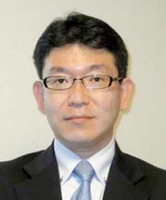Home > About Us > Sustainability Management > Sustainability Report > Sustainability Report 2011 > Third-Party Comment
 Third-Party Comment
Third-Party Comment
| Comments on reading the Kobe Steel Group's Sustainability Report 2011 |
Reading the Kobe Steel Group Sustainability Report 2011, I got a strong sense that the Kobe Steel Group is starting to move up to the next level and break new ground compared to previous sustainability reports. It's difficult to sum it up in just a few words, but there is a sense that priorities have been identified from a broader perspective, and that the Group is moving in a new direction in an effort to achieve its overall vision for CSR.
The increased use of words such as "partnership", "harmony" and "cooperation" is symbolic of this change in direction. It is definitely more pronounced in the second part of the report, dealing with social initiatives, but these are nonetheless the key words that underpin this year's report.
On a specific level, I was struck by the emphasis on cooperation with the local community as one of the cornerstones of the Kobe Steel Group, as highlighted in the special feature on Nadahama Science Square. The sections outlining social initiatives based on respect for different cultures and practices in other countries similarly capture the Group's commitment to cooperation on a global scale. The report also creates a strong sense of sympathy that is unique to the Kobe Steel Group, having experienced the Great Hanshin-Awaji Earthquake, particularly in terms of solidarity between the engineers working to restore the Huachipato Blast Furnace in Chile and President Sato's message to those affected by the Great East Japan Earthquake at the start of the report.
This extends to the relationship between the report and its readers. While retaining the best qualities of the previous year's report, including (1) reductions in CO2 emissions in each sector, (2) reductions in environmental impact via individual products and services, and (3) messages from the heads of individual plants and works, the 2011 report also adopts a more barrier-free approach, by using simplified diagrams and significantly reducing the number of words, which makes a major improvement in readability.
Although this year's report covers a wide range of activities carried out by the Kobe Steel Group, based on the theme of partnership and cooperation, and offers a broad overview of the Group's vision for CSR in the future, it is still in the process of transition. As such there are still a number of issues to be addressed. The first of these relates to the integration of CSR. Page 13 of the report sets out the Kobe Steel Group Corporate Code of Ethics, Standards of Corporate Conduct and corporate activities as separate components that function effectively together. Whereas this may have been fine in the past, it suggests that the Group's CSR vision isn't really integrated into the report on a fundamental level. This makes it somewhat harder to understand the connection between the subsequent sections on the environment and social contribution, and is an issue that ought to be addressed in the future.
On other fronts, the report would benefit from a stronger focus from the perspective of the Group's stakeholders. As I mentioned last year, it is important to feature comments from the likes of users and suppliers, in order to effectively examine society's needs, as the flipside of CSR management. It would also be better to tackle biodiversity, the subject of this year's main special feature, with reference to the supply chain, so as to clearly spell out how it relates to the Group's business activities.
The 2011 report stands out as the Kobe Steel Group's most complete sustainability report to date. I have high hopes for next year's report and am fascinated to see how it will evolve.

Keisuke Takegahara Head of Environmental Initiative and Corporate Social Responsibility Support Department Development Bank of Japan Profile
Keisuke Takegahara graduated from Hitotsubashi University Faculty of Law and joined Japan Development Bank (now Development Bank of Japan) in 1989. He went on to work as Deputy Director of the Policy Planning Department (in charge of planning environmental investment), and as Manager of the CSR Promotion Office (Business Development Department) before being appointed to his current position. Previous posts have included part-time graduate school lecturer at the University of Tokyo, member of the Ministry of Economy, Trade and Industry's Study Committee on the Evaluation of Environmental Capabilities in the Financial Market and member of the Ministry of the Environment's Review Committee for Industries and Services subject to Surveys into the Scale of Environmental Business Markets and Employment. Since 2009, he has also been a member of the Central Environmental Council General Policy Committee's Specialist Committee on Finance and the Environment. |
Editorial Postscript
In the Kobe Steel Group Sustainability Report 2011, we have focused on clearly conveying our approach to CSR and improving the readability of the report. In addition to the main special feature on the Group’s Nadahama Science Square facility, we have included special features on our biodiversity initiatives in the environmental section of the report and on our efforts to help restore blast furnace operations following an earthquake in Chile in the social section. We have also worked hard to communicate how committed we are to all of our stakeholders. We look forward to receiving honest opinions from readers, as we strive to make our reports even more comprehensive in the future.
Secretariat and Publicity Department
Kobe Steel, Ltd.


